Trade Policy and Development in Developing Countries
VerifiedAdded on 2020/05/28
|16
|4472
|127
AI Summary
This assignment delves into the complexities of trade policy and its influence on development within developing nations. It examines environmental concerns, institutional frameworks, regional integration, and the role of international organizations like the WTO. The focus is on understanding how trade policies can either hinder or promote sustainable economic growth and social progress in these countries.
Contribute Materials
Your contribution can guide someone’s learning journey. Share your
documents today.
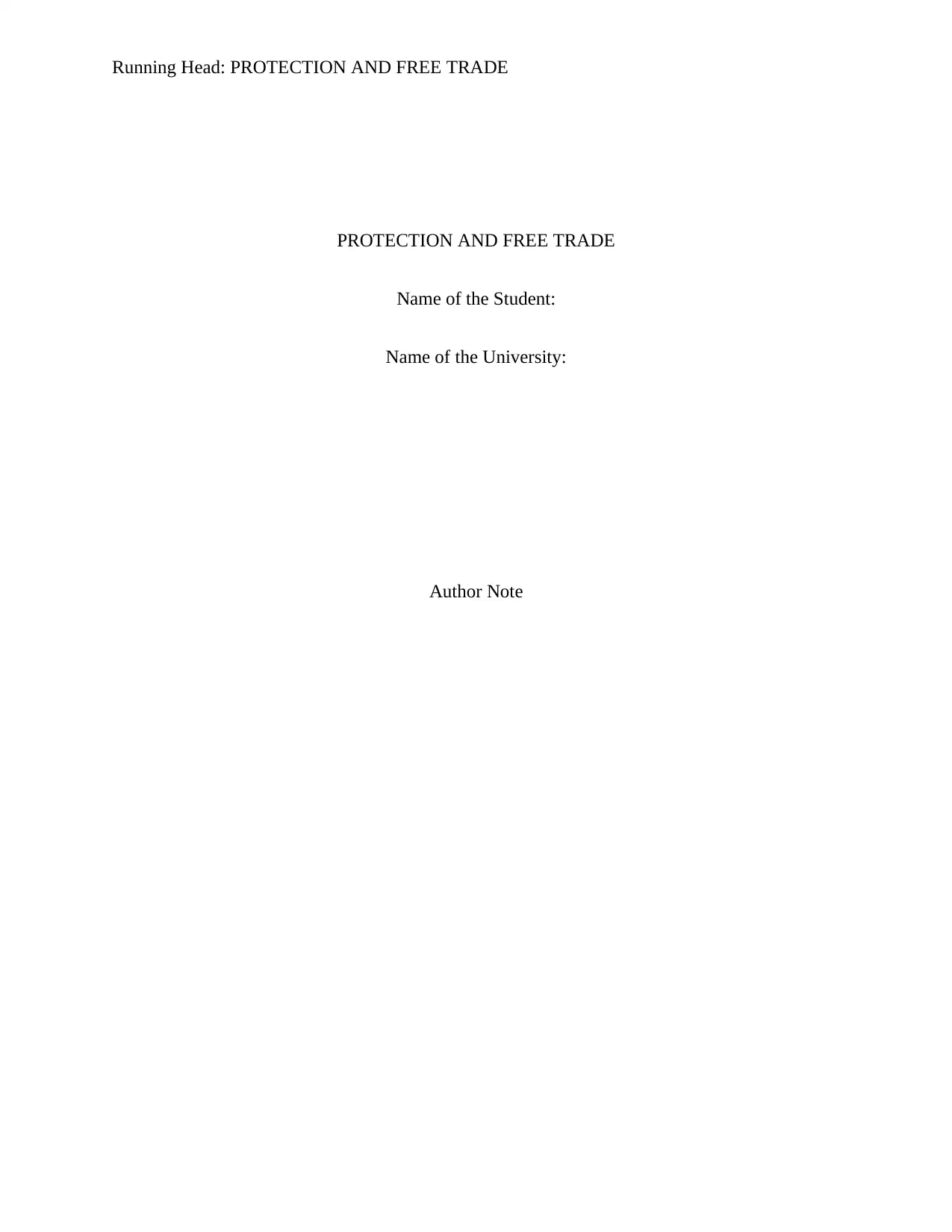
Running Head: PROTECTION AND FREE TRADE
PROTECTION AND FREE TRADE
Name of the Student:
Name of the University:
Author Note
PROTECTION AND FREE TRADE
Name of the Student:
Name of the University:
Author Note
Secure Best Marks with AI Grader
Need help grading? Try our AI Grader for instant feedback on your assignments.
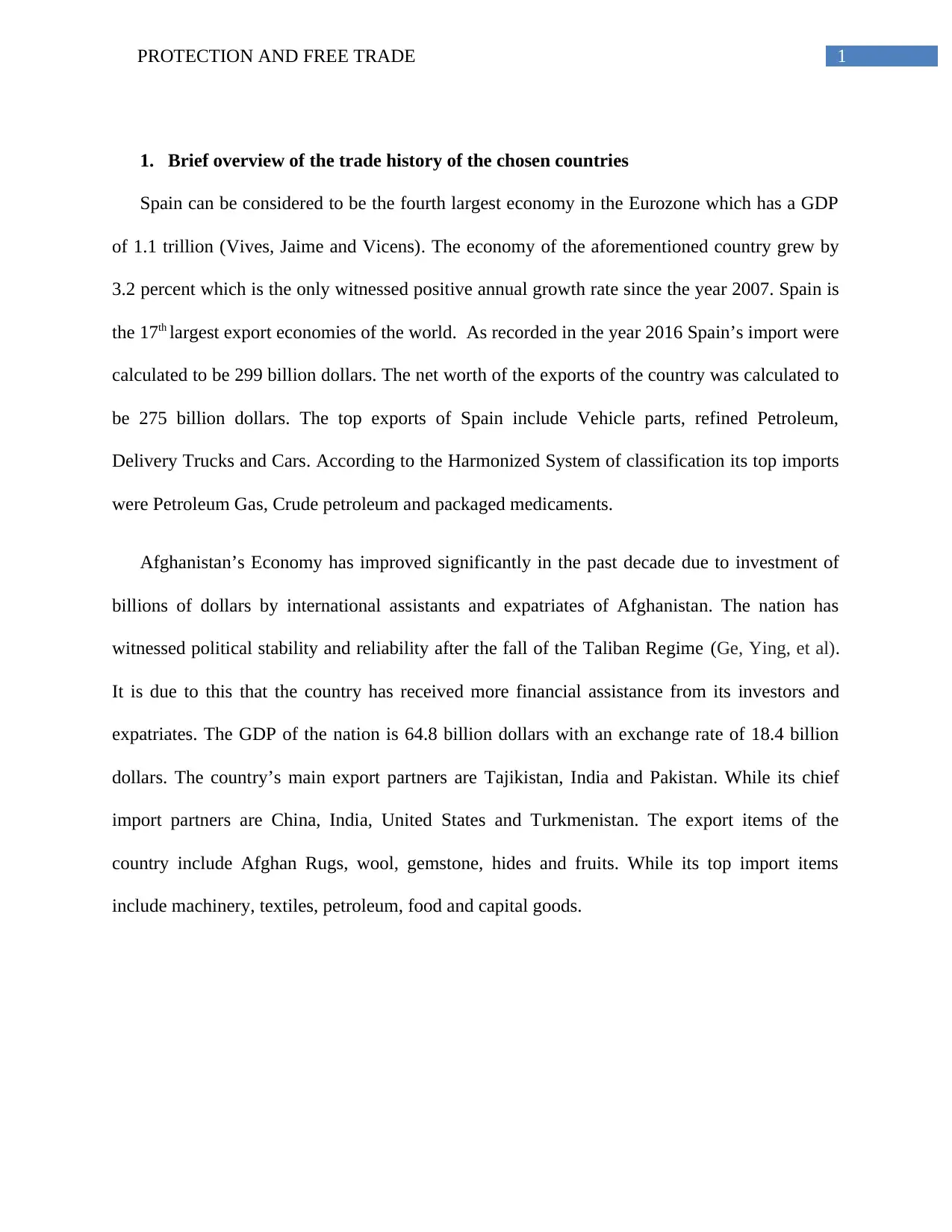
1PROTECTION AND FREE TRADE
1. Brief overview of the trade history of the chosen countries
Spain can be considered to be the fourth largest economy in the Eurozone which has a GDP
of 1.1 trillion (Vives, Jaime and Vicens). The economy of the aforementioned country grew by
3.2 percent which is the only witnessed positive annual growth rate since the year 2007. Spain is
the 17th largest export economies of the world. As recorded in the year 2016 Spain’s import were
calculated to be 299 billion dollars. The net worth of the exports of the country was calculated to
be 275 billion dollars. The top exports of Spain include Vehicle parts, refined Petroleum,
Delivery Trucks and Cars. According to the Harmonized System of classification its top imports
were Petroleum Gas, Crude petroleum and packaged medicaments.
Afghanistan’s Economy has improved significantly in the past decade due to investment of
billions of dollars by international assistants and expatriates of Afghanistan. The nation has
witnessed political stability and reliability after the fall of the Taliban Regime (Ge, Ying, et al).
It is due to this that the country has received more financial assistance from its investors and
expatriates. The GDP of the nation is 64.8 billion dollars with an exchange rate of 18.4 billion
dollars. The country’s main export partners are Tajikistan, India and Pakistan. While its chief
import partners are China, India, United States and Turkmenistan. The export items of the
country include Afghan Rugs, wool, gemstone, hides and fruits. While its top import items
include machinery, textiles, petroleum, food and capital goods.
1. Brief overview of the trade history of the chosen countries
Spain can be considered to be the fourth largest economy in the Eurozone which has a GDP
of 1.1 trillion (Vives, Jaime and Vicens). The economy of the aforementioned country grew by
3.2 percent which is the only witnessed positive annual growth rate since the year 2007. Spain is
the 17th largest export economies of the world. As recorded in the year 2016 Spain’s import were
calculated to be 299 billion dollars. The net worth of the exports of the country was calculated to
be 275 billion dollars. The top exports of Spain include Vehicle parts, refined Petroleum,
Delivery Trucks and Cars. According to the Harmonized System of classification its top imports
were Petroleum Gas, Crude petroleum and packaged medicaments.
Afghanistan’s Economy has improved significantly in the past decade due to investment of
billions of dollars by international assistants and expatriates of Afghanistan. The nation has
witnessed political stability and reliability after the fall of the Taliban Regime (Ge, Ying, et al).
It is due to this that the country has received more financial assistance from its investors and
expatriates. The GDP of the nation is 64.8 billion dollars with an exchange rate of 18.4 billion
dollars. The country’s main export partners are Tajikistan, India and Pakistan. While its chief
import partners are China, India, United States and Turkmenistan. The export items of the
country include Afghan Rugs, wool, gemstone, hides and fruits. While its top import items
include machinery, textiles, petroleum, food and capital goods.
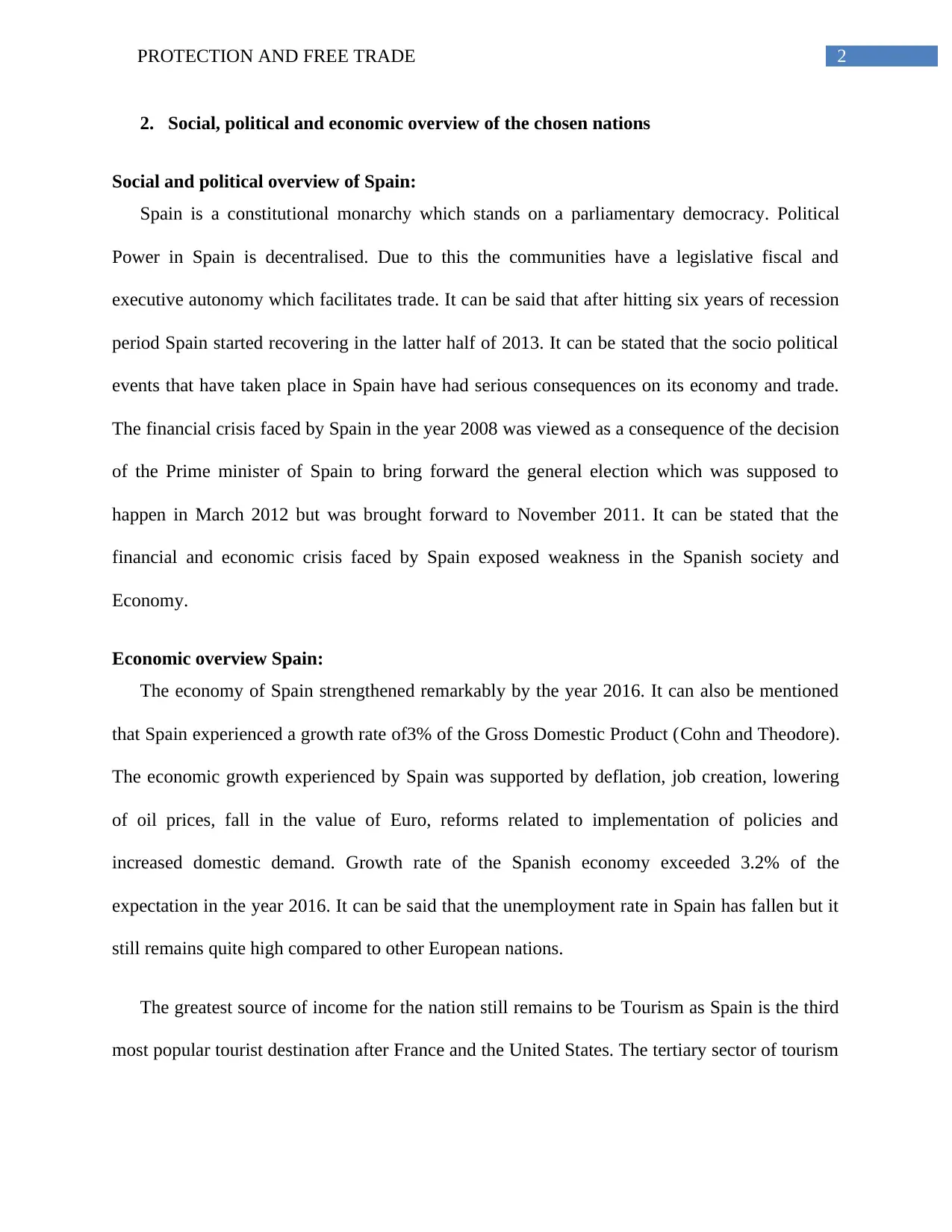
2PROTECTION AND FREE TRADE
2. Social, political and economic overview of the chosen nations
Social and political overview of Spain:
Spain is a constitutional monarchy which stands on a parliamentary democracy. Political
Power in Spain is decentralised. Due to this the communities have a legislative fiscal and
executive autonomy which facilitates trade. It can be said that after hitting six years of recession
period Spain started recovering in the latter half of 2013. It can be stated that the socio political
events that have taken place in Spain have had serious consequences on its economy and trade.
The financial crisis faced by Spain in the year 2008 was viewed as a consequence of the decision
of the Prime minister of Spain to bring forward the general election which was supposed to
happen in March 2012 but was brought forward to November 2011. It can be stated that the
financial and economic crisis faced by Spain exposed weakness in the Spanish society and
Economy.
Economic overview Spain:
The economy of Spain strengthened remarkably by the year 2016. It can also be mentioned
that Spain experienced a growth rate of3% of the Gross Domestic Product (Cohn and Theodore).
The economic growth experienced by Spain was supported by deflation, job creation, lowering
of oil prices, fall in the value of Euro, reforms related to implementation of policies and
increased domestic demand. Growth rate of the Spanish economy exceeded 3.2% of the
expectation in the year 2016. It can be said that the unemployment rate in Spain has fallen but it
still remains quite high compared to other European nations.
The greatest source of income for the nation still remains to be Tourism as Spain is the third
most popular tourist destination after France and the United States. The tertiary sector of tourism
2. Social, political and economic overview of the chosen nations
Social and political overview of Spain:
Spain is a constitutional monarchy which stands on a parliamentary democracy. Political
Power in Spain is decentralised. Due to this the communities have a legislative fiscal and
executive autonomy which facilitates trade. It can be said that after hitting six years of recession
period Spain started recovering in the latter half of 2013. It can be stated that the socio political
events that have taken place in Spain have had serious consequences on its economy and trade.
The financial crisis faced by Spain in the year 2008 was viewed as a consequence of the decision
of the Prime minister of Spain to bring forward the general election which was supposed to
happen in March 2012 but was brought forward to November 2011. It can be stated that the
financial and economic crisis faced by Spain exposed weakness in the Spanish society and
Economy.
Economic overview Spain:
The economy of Spain strengthened remarkably by the year 2016. It can also be mentioned
that Spain experienced a growth rate of3% of the Gross Domestic Product (Cohn and Theodore).
The economic growth experienced by Spain was supported by deflation, job creation, lowering
of oil prices, fall in the value of Euro, reforms related to implementation of policies and
increased domestic demand. Growth rate of the Spanish economy exceeded 3.2% of the
expectation in the year 2016. It can be said that the unemployment rate in Spain has fallen but it
still remains quite high compared to other European nations.
The greatest source of income for the nation still remains to be Tourism as Spain is the third
most popular tourist destination after France and the United States. The tertiary sector of tourism
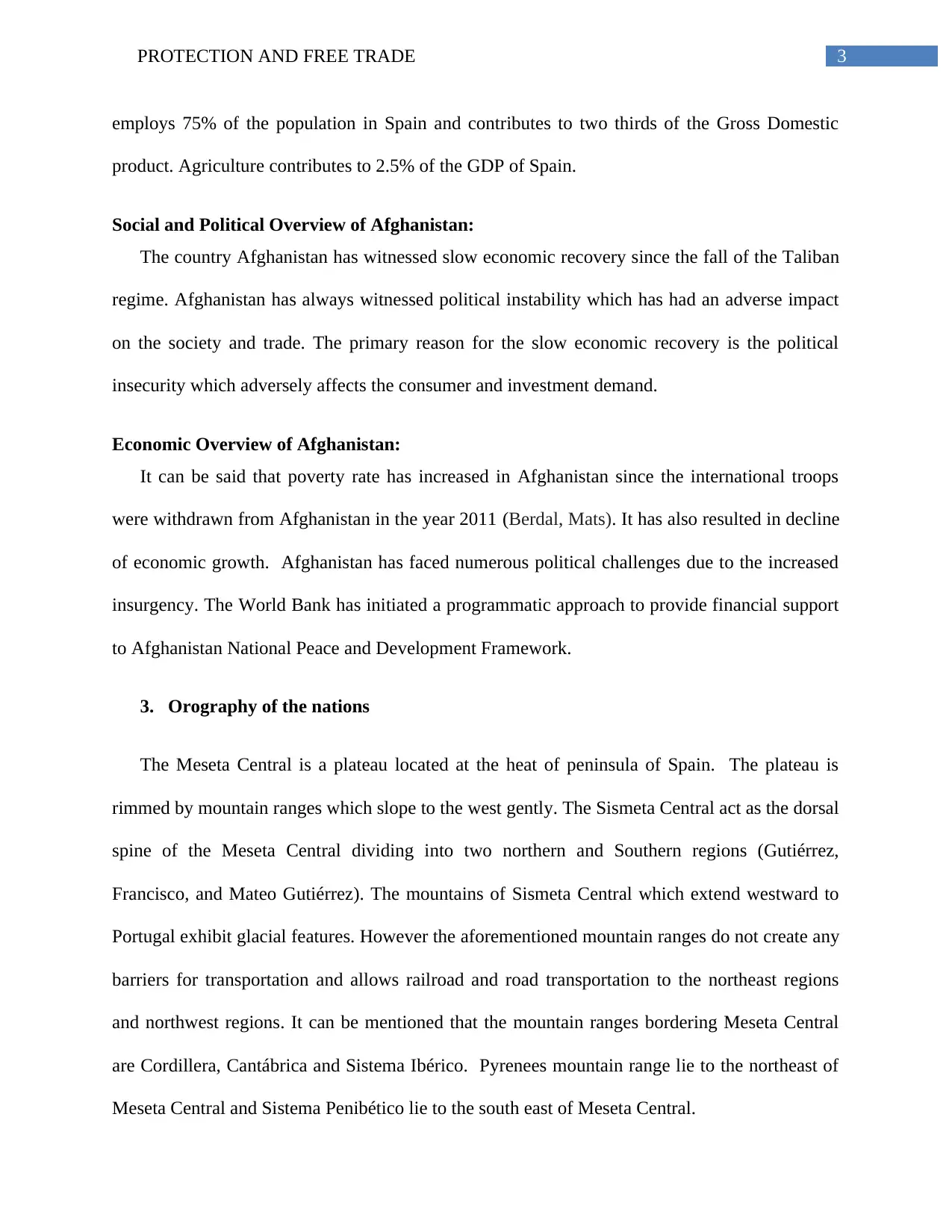
3PROTECTION AND FREE TRADE
employs 75% of the population in Spain and contributes to two thirds of the Gross Domestic
product. Agriculture contributes to 2.5% of the GDP of Spain.
Social and Political Overview of Afghanistan:
The country Afghanistan has witnessed slow economic recovery since the fall of the Taliban
regime. Afghanistan has always witnessed political instability which has had an adverse impact
on the society and trade. The primary reason for the slow economic recovery is the political
insecurity which adversely affects the consumer and investment demand.
Economic Overview of Afghanistan:
It can be said that poverty rate has increased in Afghanistan since the international troops
were withdrawn from Afghanistan in the year 2011 (Berdal, Mats). It has also resulted in decline
of economic growth. Afghanistan has faced numerous political challenges due to the increased
insurgency. The World Bank has initiated a programmatic approach to provide financial support
to Afghanistan National Peace and Development Framework.
3. Orography of the nations
The Meseta Central is a plateau located at the heat of peninsula of Spain. The plateau is
rimmed by mountain ranges which slope to the west gently. The Sismeta Central act as the dorsal
spine of the Meseta Central dividing into two northern and Southern regions (Gutiérrez,
Francisco, and Mateo Gutiérrez). The mountains of Sismeta Central which extend westward to
Portugal exhibit glacial features. However the aforementioned mountain ranges do not create any
barriers for transportation and allows railroad and road transportation to the northeast regions
and northwest regions. It can be mentioned that the mountain ranges bordering Meseta Central
are Cordillera, Cantábrica and Sistema Ibérico. Pyrenees mountain range lie to the northeast of
Meseta Central and Sistema Penibético lie to the south east of Meseta Central.
employs 75% of the population in Spain and contributes to two thirds of the Gross Domestic
product. Agriculture contributes to 2.5% of the GDP of Spain.
Social and Political Overview of Afghanistan:
The country Afghanistan has witnessed slow economic recovery since the fall of the Taliban
regime. Afghanistan has always witnessed political instability which has had an adverse impact
on the society and trade. The primary reason for the slow economic recovery is the political
insecurity which adversely affects the consumer and investment demand.
Economic Overview of Afghanistan:
It can be said that poverty rate has increased in Afghanistan since the international troops
were withdrawn from Afghanistan in the year 2011 (Berdal, Mats). It has also resulted in decline
of economic growth. Afghanistan has faced numerous political challenges due to the increased
insurgency. The World Bank has initiated a programmatic approach to provide financial support
to Afghanistan National Peace and Development Framework.
3. Orography of the nations
The Meseta Central is a plateau located at the heat of peninsula of Spain. The plateau is
rimmed by mountain ranges which slope to the west gently. The Sismeta Central act as the dorsal
spine of the Meseta Central dividing into two northern and Southern regions (Gutiérrez,
Francisco, and Mateo Gutiérrez). The mountains of Sismeta Central which extend westward to
Portugal exhibit glacial features. However the aforementioned mountain ranges do not create any
barriers for transportation and allows railroad and road transportation to the northeast regions
and northwest regions. It can be mentioned that the mountain ranges bordering Meseta Central
are Cordillera, Cantábrica and Sistema Ibérico. Pyrenees mountain range lie to the northeast of
Meseta Central and Sistema Penibético lie to the south east of Meseta Central.
Secure Best Marks with AI Grader
Need help grading? Try our AI Grader for instant feedback on your assignments.
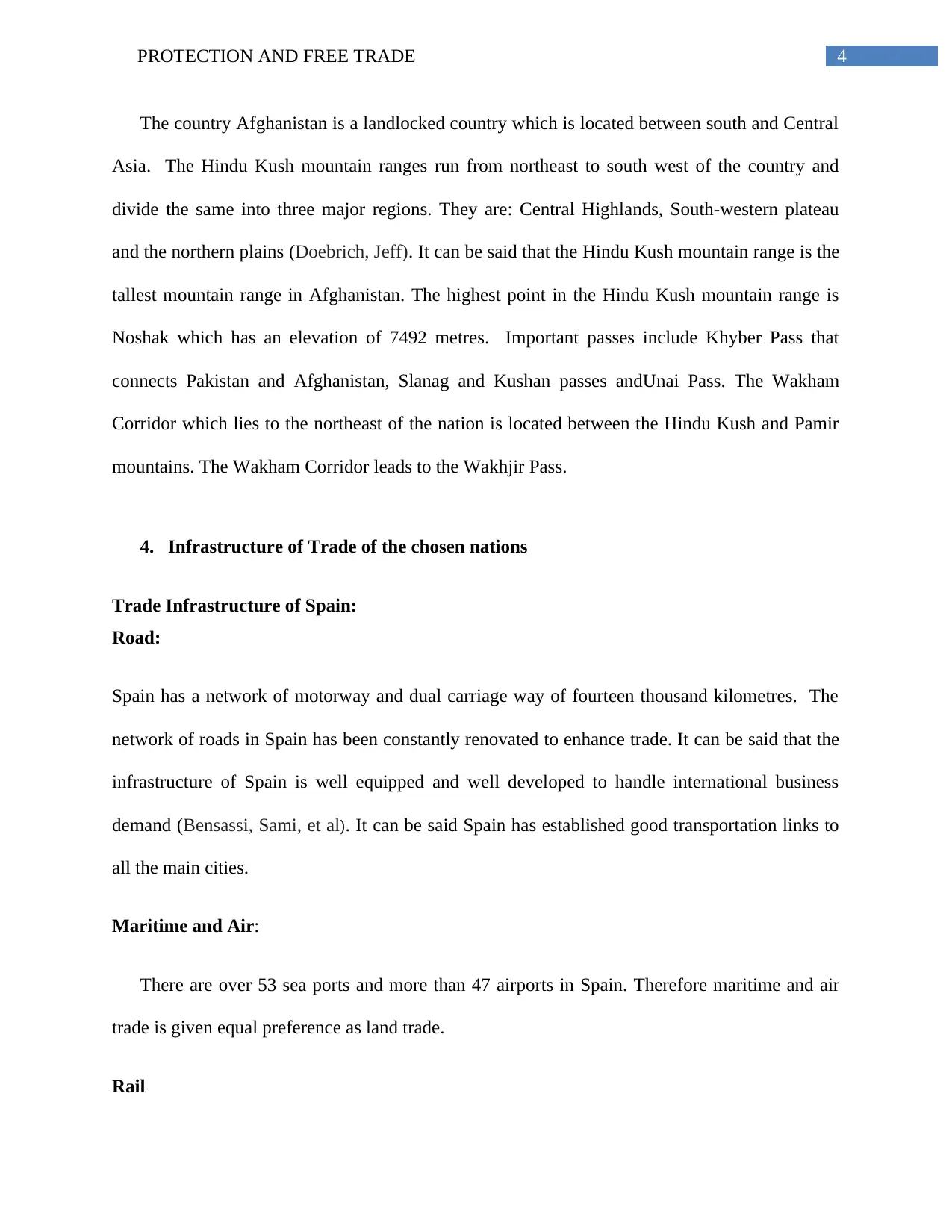
4PROTECTION AND FREE TRADE
The country Afghanistan is a landlocked country which is located between south and Central
Asia. The Hindu Kush mountain ranges run from northeast to south west of the country and
divide the same into three major regions. They are: Central Highlands, South-western plateau
and the northern plains (Doebrich, Jeff). It can be said that the Hindu Kush mountain range is the
tallest mountain range in Afghanistan. The highest point in the Hindu Kush mountain range is
Noshak which has an elevation of 7492 metres. Important passes include Khyber Pass that
connects Pakistan and Afghanistan, Slanag and Kushan passes andUnai Pass. The Wakham
Corridor which lies to the northeast of the nation is located between the Hindu Kush and Pamir
mountains. The Wakham Corridor leads to the Wakhjir Pass.
4. Infrastructure of Trade of the chosen nations
Trade Infrastructure of Spain:
Road:
Spain has a network of motorway and dual carriage way of fourteen thousand kilometres. The
network of roads in Spain has been constantly renovated to enhance trade. It can be said that the
infrastructure of Spain is well equipped and well developed to handle international business
demand (Bensassi, Sami, et al). It can be said Spain has established good transportation links to
all the main cities.
Maritime and Air:
There are over 53 sea ports and more than 47 airports in Spain. Therefore maritime and air
trade is given equal preference as land trade.
Rail
The country Afghanistan is a landlocked country which is located between south and Central
Asia. The Hindu Kush mountain ranges run from northeast to south west of the country and
divide the same into three major regions. They are: Central Highlands, South-western plateau
and the northern plains (Doebrich, Jeff). It can be said that the Hindu Kush mountain range is the
tallest mountain range in Afghanistan. The highest point in the Hindu Kush mountain range is
Noshak which has an elevation of 7492 metres. Important passes include Khyber Pass that
connects Pakistan and Afghanistan, Slanag and Kushan passes andUnai Pass. The Wakham
Corridor which lies to the northeast of the nation is located between the Hindu Kush and Pamir
mountains. The Wakham Corridor leads to the Wakhjir Pass.
4. Infrastructure of Trade of the chosen nations
Trade Infrastructure of Spain:
Road:
Spain has a network of motorway and dual carriage way of fourteen thousand kilometres. The
network of roads in Spain has been constantly renovated to enhance trade. It can be said that the
infrastructure of Spain is well equipped and well developed to handle international business
demand (Bensassi, Sami, et al). It can be said Spain has established good transportation links to
all the main cities.
Maritime and Air:
There are over 53 sea ports and more than 47 airports in Spain. Therefore maritime and air
trade is given equal preference as land trade.
Rail
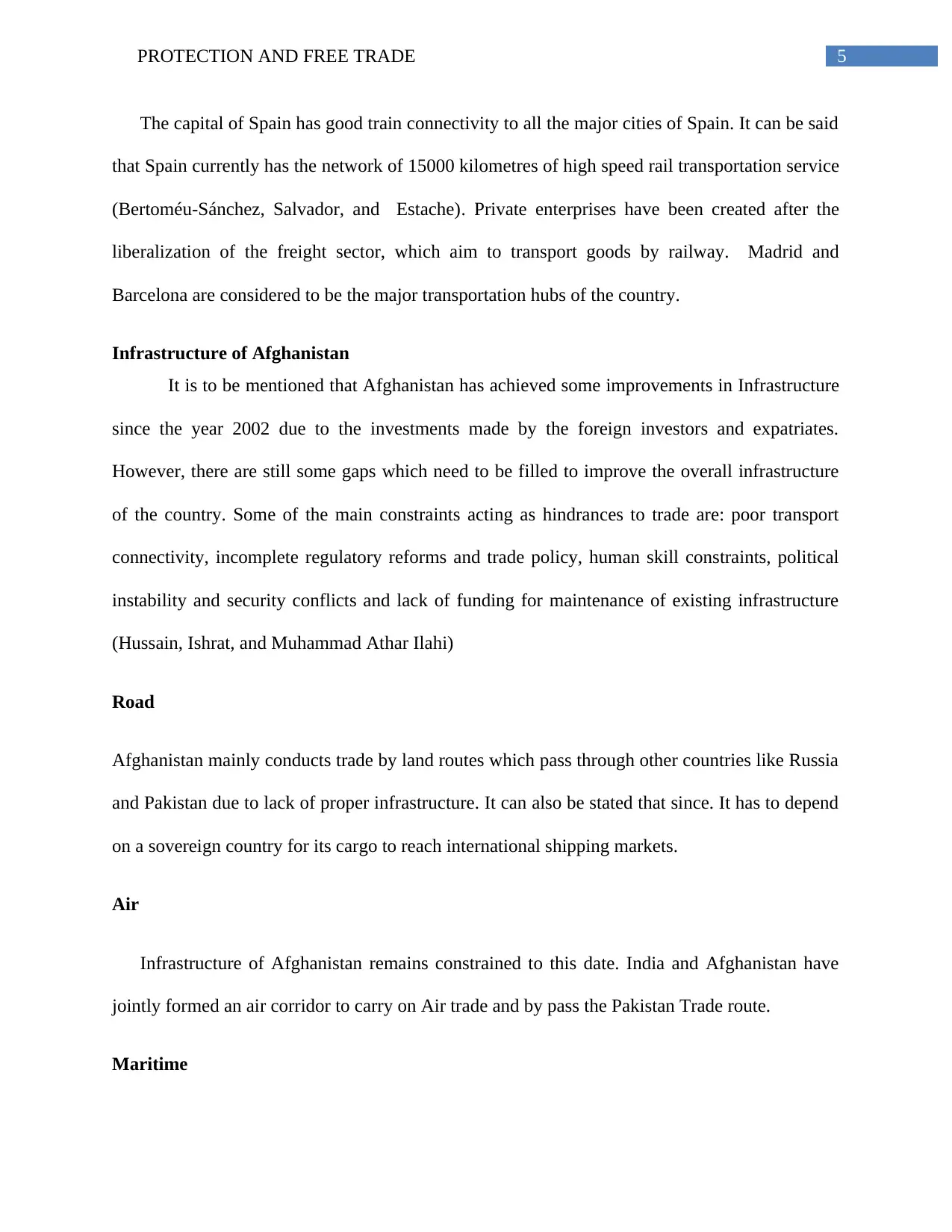
5PROTECTION AND FREE TRADE
The capital of Spain has good train connectivity to all the major cities of Spain. It can be said
that Spain currently has the network of 15000 kilometres of high speed rail transportation service
(Bertoméu-Sánchez, Salvador, and Estache). Private enterprises have been created after the
liberalization of the freight sector, which aim to transport goods by railway. Madrid and
Barcelona are considered to be the major transportation hubs of the country.
Infrastructure of Afghanistan
It is to be mentioned that Afghanistan has achieved some improvements in Infrastructure
since the year 2002 due to the investments made by the foreign investors and expatriates.
However, there are still some gaps which need to be filled to improve the overall infrastructure
of the country. Some of the main constraints acting as hindrances to trade are: poor transport
connectivity, incomplete regulatory reforms and trade policy, human skill constraints, political
instability and security conflicts and lack of funding for maintenance of existing infrastructure
(Hussain, Ishrat, and Muhammad Athar Ilahi)
Road
Afghanistan mainly conducts trade by land routes which pass through other countries like Russia
and Pakistan due to lack of proper infrastructure. It can also be stated that since. It has to depend
on a sovereign country for its cargo to reach international shipping markets.
Air
Infrastructure of Afghanistan remains constrained to this date. India and Afghanistan have
jointly formed an air corridor to carry on Air trade and by pass the Pakistan Trade route.
Maritime
The capital of Spain has good train connectivity to all the major cities of Spain. It can be said
that Spain currently has the network of 15000 kilometres of high speed rail transportation service
(Bertoméu-Sánchez, Salvador, and Estache). Private enterprises have been created after the
liberalization of the freight sector, which aim to transport goods by railway. Madrid and
Barcelona are considered to be the major transportation hubs of the country.
Infrastructure of Afghanistan
It is to be mentioned that Afghanistan has achieved some improvements in Infrastructure
since the year 2002 due to the investments made by the foreign investors and expatriates.
However, there are still some gaps which need to be filled to improve the overall infrastructure
of the country. Some of the main constraints acting as hindrances to trade are: poor transport
connectivity, incomplete regulatory reforms and trade policy, human skill constraints, political
instability and security conflicts and lack of funding for maintenance of existing infrastructure
(Hussain, Ishrat, and Muhammad Athar Ilahi)
Road
Afghanistan mainly conducts trade by land routes which pass through other countries like Russia
and Pakistan due to lack of proper infrastructure. It can also be stated that since. It has to depend
on a sovereign country for its cargo to reach international shipping markets.
Air
Infrastructure of Afghanistan remains constrained to this date. India and Afghanistan have
jointly formed an air corridor to carry on Air trade and by pass the Pakistan Trade route.
Maritime
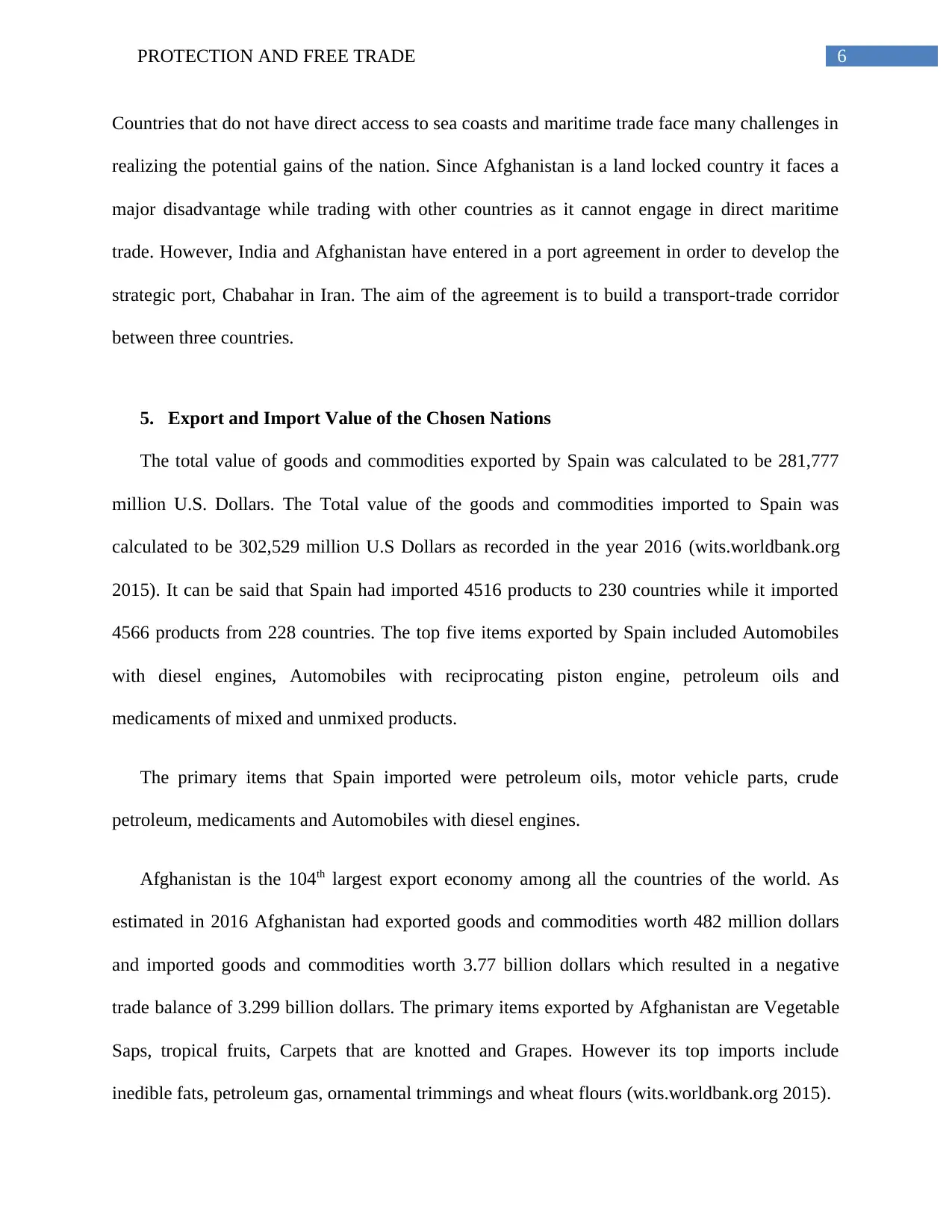
6PROTECTION AND FREE TRADE
Countries that do not have direct access to sea coasts and maritime trade face many challenges in
realizing the potential gains of the nation. Since Afghanistan is a land locked country it faces a
major disadvantage while trading with other countries as it cannot engage in direct maritime
trade. However, India and Afghanistan have entered in a port agreement in order to develop the
strategic port, Chabahar in Iran. The aim of the agreement is to build a transport-trade corridor
between three countries.
5. Export and Import Value of the Chosen Nations
The total value of goods and commodities exported by Spain was calculated to be 281,777
million U.S. Dollars. The Total value of the goods and commodities imported to Spain was
calculated to be 302,529 million U.S Dollars as recorded in the year 2016 (wits.worldbank.org
2015). It can be said that Spain had imported 4516 products to 230 countries while it imported
4566 products from 228 countries. The top five items exported by Spain included Automobiles
with diesel engines, Automobiles with reciprocating piston engine, petroleum oils and
medicaments of mixed and unmixed products.
The primary items that Spain imported were petroleum oils, motor vehicle parts, crude
petroleum, medicaments and Automobiles with diesel engines.
Afghanistan is the 104th largest export economy among all the countries of the world. As
estimated in 2016 Afghanistan had exported goods and commodities worth 482 million dollars
and imported goods and commodities worth 3.77 billion dollars which resulted in a negative
trade balance of 3.299 billion dollars. The primary items exported by Afghanistan are Vegetable
Saps, tropical fruits, Carpets that are knotted and Grapes. However its top imports include
inedible fats, petroleum gas, ornamental trimmings and wheat flours (wits.worldbank.org 2015).
Countries that do not have direct access to sea coasts and maritime trade face many challenges in
realizing the potential gains of the nation. Since Afghanistan is a land locked country it faces a
major disadvantage while trading with other countries as it cannot engage in direct maritime
trade. However, India and Afghanistan have entered in a port agreement in order to develop the
strategic port, Chabahar in Iran. The aim of the agreement is to build a transport-trade corridor
between three countries.
5. Export and Import Value of the Chosen Nations
The total value of goods and commodities exported by Spain was calculated to be 281,777
million U.S. Dollars. The Total value of the goods and commodities imported to Spain was
calculated to be 302,529 million U.S Dollars as recorded in the year 2016 (wits.worldbank.org
2015). It can be said that Spain had imported 4516 products to 230 countries while it imported
4566 products from 228 countries. The top five items exported by Spain included Automobiles
with diesel engines, Automobiles with reciprocating piston engine, petroleum oils and
medicaments of mixed and unmixed products.
The primary items that Spain imported were petroleum oils, motor vehicle parts, crude
petroleum, medicaments and Automobiles with diesel engines.
Afghanistan is the 104th largest export economy among all the countries of the world. As
estimated in 2016 Afghanistan had exported goods and commodities worth 482 million dollars
and imported goods and commodities worth 3.77 billion dollars which resulted in a negative
trade balance of 3.299 billion dollars. The primary items exported by Afghanistan are Vegetable
Saps, tropical fruits, Carpets that are knotted and Grapes. However its top imports include
inedible fats, petroleum gas, ornamental trimmings and wheat flours (wits.worldbank.org 2015).
Paraphrase This Document
Need a fresh take? Get an instant paraphrase of this document with our AI Paraphraser
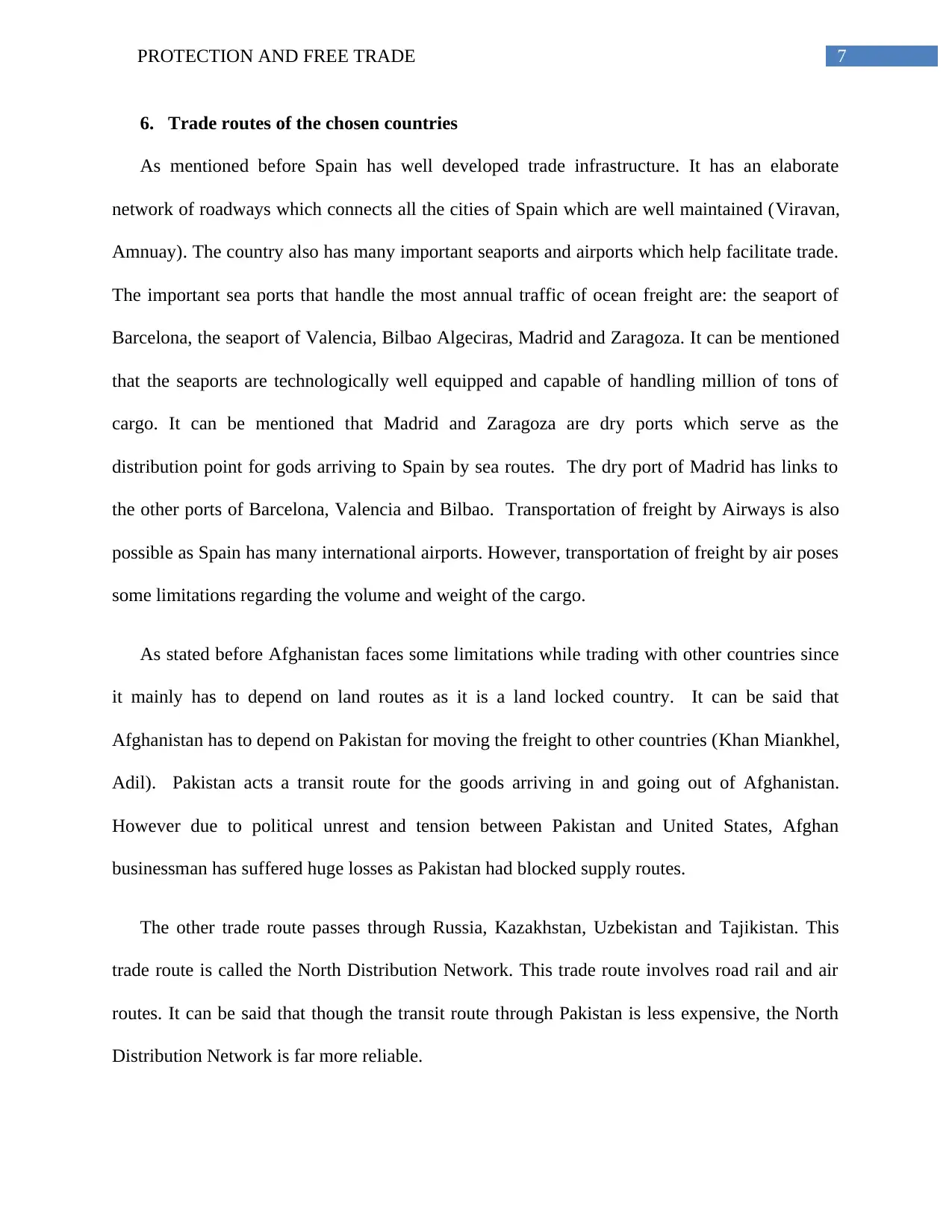
7PROTECTION AND FREE TRADE
6. Trade routes of the chosen countries
As mentioned before Spain has well developed trade infrastructure. It has an elaborate
network of roadways which connects all the cities of Spain which are well maintained (Viravan,
Amnuay). The country also has many important seaports and airports which help facilitate trade.
The important sea ports that handle the most annual traffic of ocean freight are: the seaport of
Barcelona, the seaport of Valencia, Bilbao Algeciras, Madrid and Zaragoza. It can be mentioned
that the seaports are technologically well equipped and capable of handling million of tons of
cargo. It can be mentioned that Madrid and Zaragoza are dry ports which serve as the
distribution point for gods arriving to Spain by sea routes. The dry port of Madrid has links to
the other ports of Barcelona, Valencia and Bilbao. Transportation of freight by Airways is also
possible as Spain has many international airports. However, transportation of freight by air poses
some limitations regarding the volume and weight of the cargo.
As stated before Afghanistan faces some limitations while trading with other countries since
it mainly has to depend on land routes as it is a land locked country. It can be said that
Afghanistan has to depend on Pakistan for moving the freight to other countries (Khan Miankhel,
Adil). Pakistan acts a transit route for the goods arriving in and going out of Afghanistan.
However due to political unrest and tension between Pakistan and United States, Afghan
businessman has suffered huge losses as Pakistan had blocked supply routes.
The other trade route passes through Russia, Kazakhstan, Uzbekistan and Tajikistan. This
trade route is called the North Distribution Network. This trade route involves road rail and air
routes. It can be said that though the transit route through Pakistan is less expensive, the North
Distribution Network is far more reliable.
6. Trade routes of the chosen countries
As mentioned before Spain has well developed trade infrastructure. It has an elaborate
network of roadways which connects all the cities of Spain which are well maintained (Viravan,
Amnuay). The country also has many important seaports and airports which help facilitate trade.
The important sea ports that handle the most annual traffic of ocean freight are: the seaport of
Barcelona, the seaport of Valencia, Bilbao Algeciras, Madrid and Zaragoza. It can be mentioned
that the seaports are technologically well equipped and capable of handling million of tons of
cargo. It can be mentioned that Madrid and Zaragoza are dry ports which serve as the
distribution point for gods arriving to Spain by sea routes. The dry port of Madrid has links to
the other ports of Barcelona, Valencia and Bilbao. Transportation of freight by Airways is also
possible as Spain has many international airports. However, transportation of freight by air poses
some limitations regarding the volume and weight of the cargo.
As stated before Afghanistan faces some limitations while trading with other countries since
it mainly has to depend on land routes as it is a land locked country. It can be said that
Afghanistan has to depend on Pakistan for moving the freight to other countries (Khan Miankhel,
Adil). Pakistan acts a transit route for the goods arriving in and going out of Afghanistan.
However due to political unrest and tension between Pakistan and United States, Afghan
businessman has suffered huge losses as Pakistan had blocked supply routes.
The other trade route passes through Russia, Kazakhstan, Uzbekistan and Tajikistan. This
trade route is called the North Distribution Network. This trade route involves road rail and air
routes. It can be said that though the transit route through Pakistan is less expensive, the North
Distribution Network is far more reliable.
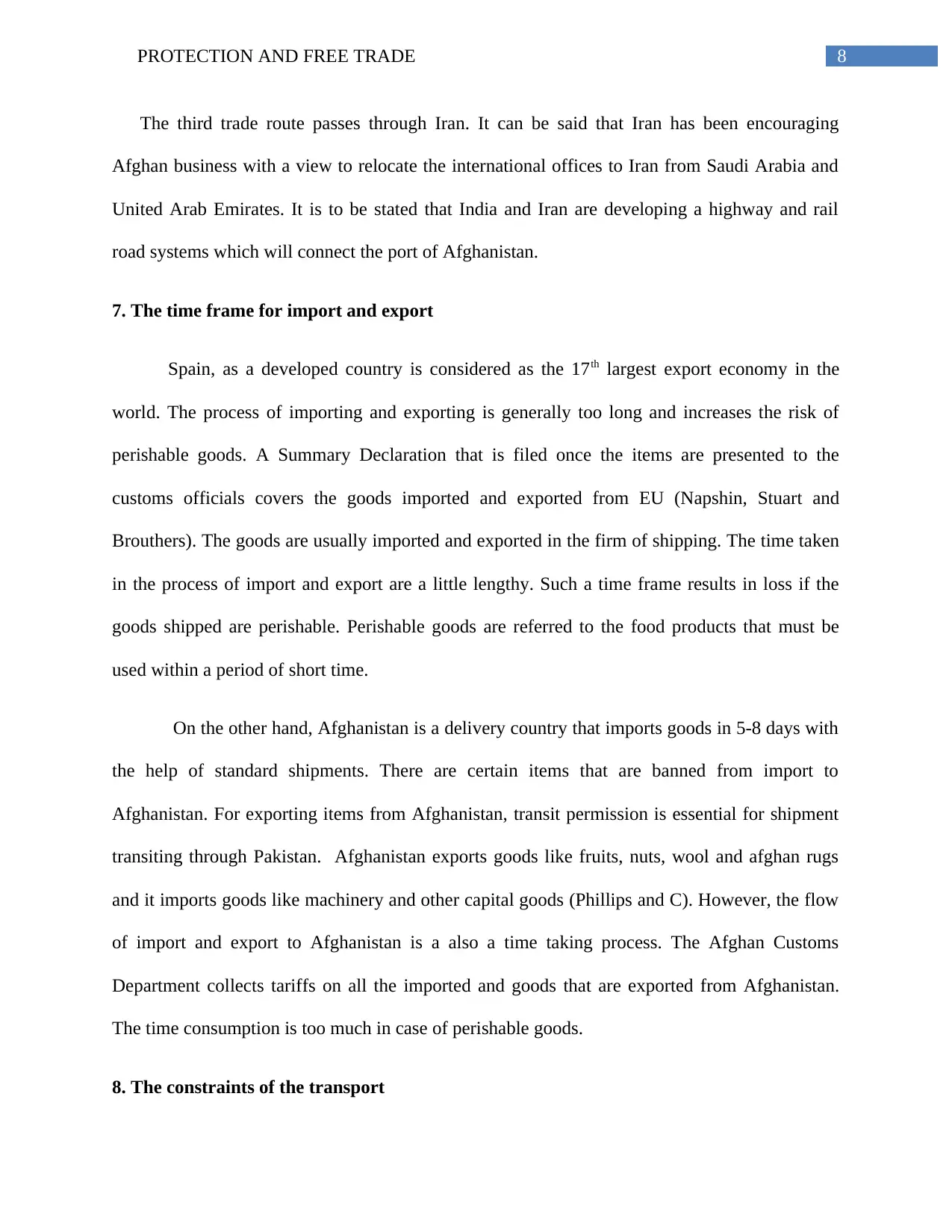
8PROTECTION AND FREE TRADE
The third trade route passes through Iran. It can be said that Iran has been encouraging
Afghan business with a view to relocate the international offices to Iran from Saudi Arabia and
United Arab Emirates. It is to be stated that India and Iran are developing a highway and rail
road systems which will connect the port of Afghanistan.
7. The time frame for import and export
Spain, as a developed country is considered as the 17th largest export economy in the
world. The process of importing and exporting is generally too long and increases the risk of
perishable goods. A Summary Declaration that is filed once the items are presented to the
customs officials covers the goods imported and exported from EU (Napshin, Stuart and
Brouthers). The goods are usually imported and exported in the firm of shipping. The time taken
in the process of import and export are a little lengthy. Such a time frame results in loss if the
goods shipped are perishable. Perishable goods are referred to the food products that must be
used within a period of short time.
On the other hand, Afghanistan is a delivery country that imports goods in 5-8 days with
the help of standard shipments. There are certain items that are banned from import to
Afghanistan. For exporting items from Afghanistan, transit permission is essential for shipment
transiting through Pakistan. Afghanistan exports goods like fruits, nuts, wool and afghan rugs
and it imports goods like machinery and other capital goods (Phillips and C). However, the flow
of import and export to Afghanistan is a also a time taking process. The Afghan Customs
Department collects tariffs on all the imported and goods that are exported from Afghanistan.
The time consumption is too much in case of perishable goods.
8. The constraints of the transport
The third trade route passes through Iran. It can be said that Iran has been encouraging
Afghan business with a view to relocate the international offices to Iran from Saudi Arabia and
United Arab Emirates. It is to be stated that India and Iran are developing a highway and rail
road systems which will connect the port of Afghanistan.
7. The time frame for import and export
Spain, as a developed country is considered as the 17th largest export economy in the
world. The process of importing and exporting is generally too long and increases the risk of
perishable goods. A Summary Declaration that is filed once the items are presented to the
customs officials covers the goods imported and exported from EU (Napshin, Stuart and
Brouthers). The goods are usually imported and exported in the firm of shipping. The time taken
in the process of import and export are a little lengthy. Such a time frame results in loss if the
goods shipped are perishable. Perishable goods are referred to the food products that must be
used within a period of short time.
On the other hand, Afghanistan is a delivery country that imports goods in 5-8 days with
the help of standard shipments. There are certain items that are banned from import to
Afghanistan. For exporting items from Afghanistan, transit permission is essential for shipment
transiting through Pakistan. Afghanistan exports goods like fruits, nuts, wool and afghan rugs
and it imports goods like machinery and other capital goods (Phillips and C). However, the flow
of import and export to Afghanistan is a also a time taking process. The Afghan Customs
Department collects tariffs on all the imported and goods that are exported from Afghanistan.
The time consumption is too much in case of perishable goods.
8. The constraints of the transport
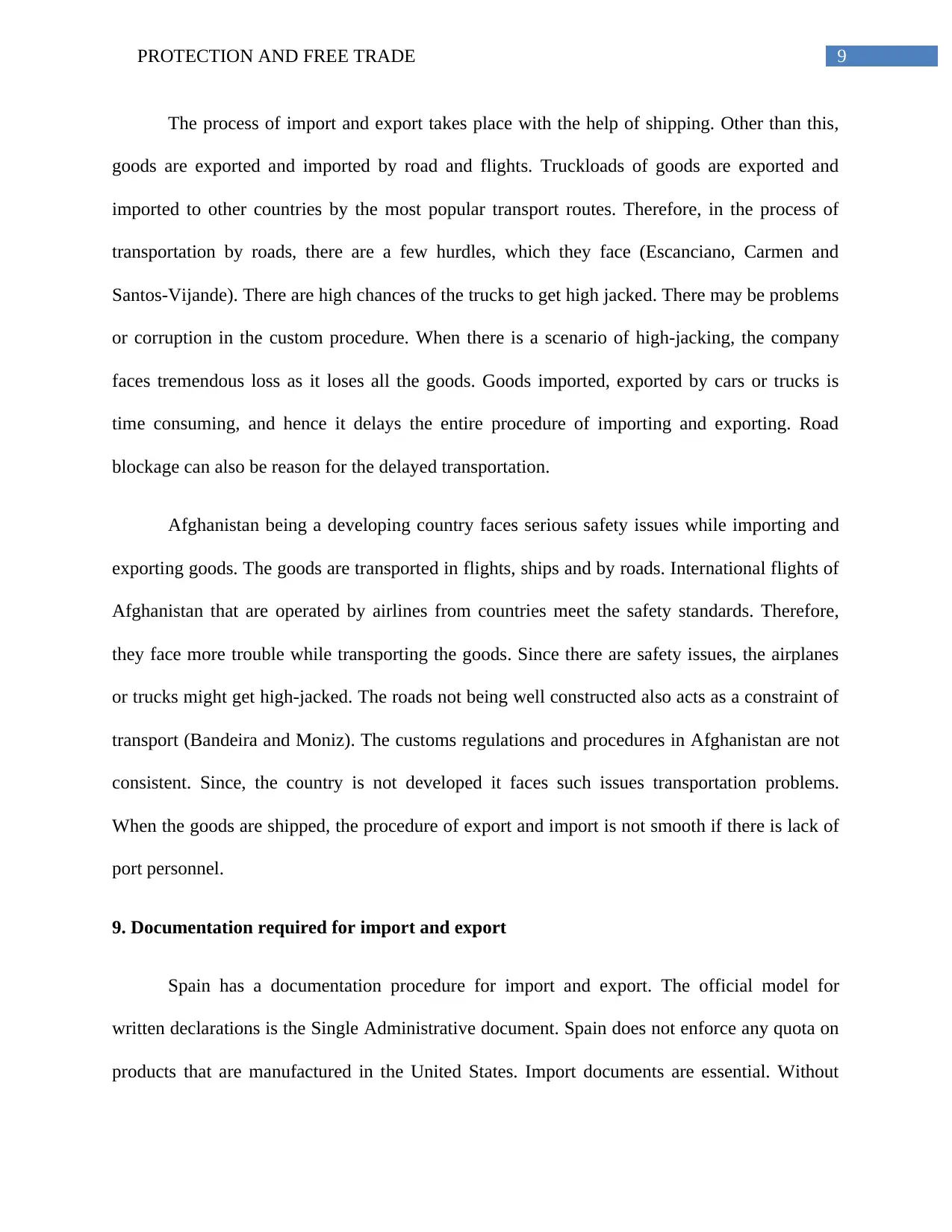
9PROTECTION AND FREE TRADE
The process of import and export takes place with the help of shipping. Other than this,
goods are exported and imported by road and flights. Truckloads of goods are exported and
imported to other countries by the most popular transport routes. Therefore, in the process of
transportation by roads, there are a few hurdles, which they face (Escanciano, Carmen and
Santos-Vijande). There are high chances of the trucks to get high jacked. There may be problems
or corruption in the custom procedure. When there is a scenario of high-jacking, the company
faces tremendous loss as it loses all the goods. Goods imported, exported by cars or trucks is
time consuming, and hence it delays the entire procedure of importing and exporting. Road
blockage can also be reason for the delayed transportation.
Afghanistan being a developing country faces serious safety issues while importing and
exporting goods. The goods are transported in flights, ships and by roads. International flights of
Afghanistan that are operated by airlines from countries meet the safety standards. Therefore,
they face more trouble while transporting the goods. Since there are safety issues, the airplanes
or trucks might get high-jacked. The roads not being well constructed also acts as a constraint of
transport (Bandeira and Moniz). The customs regulations and procedures in Afghanistan are not
consistent. Since, the country is not developed it faces such issues transportation problems.
When the goods are shipped, the procedure of export and import is not smooth if there is lack of
port personnel.
9. Documentation required for import and export
Spain has a documentation procedure for import and export. The official model for
written declarations is the Single Administrative document. Spain does not enforce any quota on
products that are manufactured in the United States. Import documents are essential. Without
The process of import and export takes place with the help of shipping. Other than this,
goods are exported and imported by road and flights. Truckloads of goods are exported and
imported to other countries by the most popular transport routes. Therefore, in the process of
transportation by roads, there are a few hurdles, which they face (Escanciano, Carmen and
Santos-Vijande). There are high chances of the trucks to get high jacked. There may be problems
or corruption in the custom procedure. When there is a scenario of high-jacking, the company
faces tremendous loss as it loses all the goods. Goods imported, exported by cars or trucks is
time consuming, and hence it delays the entire procedure of importing and exporting. Road
blockage can also be reason for the delayed transportation.
Afghanistan being a developing country faces serious safety issues while importing and
exporting goods. The goods are transported in flights, ships and by roads. International flights of
Afghanistan that are operated by airlines from countries meet the safety standards. Therefore,
they face more trouble while transporting the goods. Since there are safety issues, the airplanes
or trucks might get high-jacked. The roads not being well constructed also acts as a constraint of
transport (Bandeira and Moniz). The customs regulations and procedures in Afghanistan are not
consistent. Since, the country is not developed it faces such issues transportation problems.
When the goods are shipped, the procedure of export and import is not smooth if there is lack of
port personnel.
9. Documentation required for import and export
Spain has a documentation procedure for import and export. The official model for
written declarations is the Single Administrative document. Spain does not enforce any quota on
products that are manufactured in the United States. Import documents are essential. Without
Secure Best Marks with AI Grader
Need help grading? Try our AI Grader for instant feedback on your assignments.
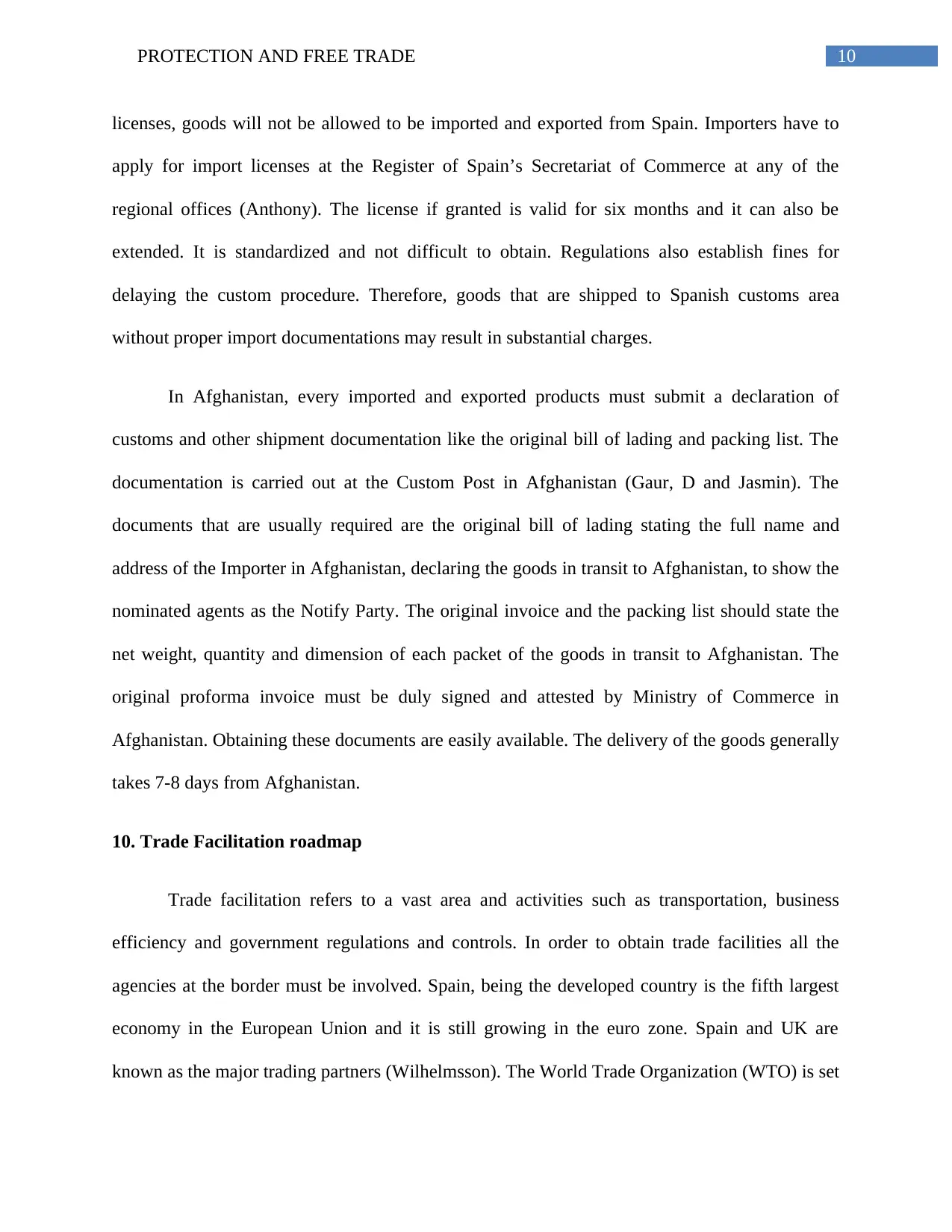
10PROTECTION AND FREE TRADE
licenses, goods will not be allowed to be imported and exported from Spain. Importers have to
apply for import licenses at the Register of Spain’s Secretariat of Commerce at any of the
regional offices (Anthony). The license if granted is valid for six months and it can also be
extended. It is standardized and not difficult to obtain. Regulations also establish fines for
delaying the custom procedure. Therefore, goods that are shipped to Spanish customs area
without proper import documentations may result in substantial charges.
In Afghanistan, every imported and exported products must submit a declaration of
customs and other shipment documentation like the original bill of lading and packing list. The
documentation is carried out at the Custom Post in Afghanistan (Gaur, D and Jasmin). The
documents that are usually required are the original bill of lading stating the full name and
address of the Importer in Afghanistan, declaring the goods in transit to Afghanistan, to show the
nominated agents as the Notify Party. The original invoice and the packing list should state the
net weight, quantity and dimension of each packet of the goods in transit to Afghanistan. The
original proforma invoice must be duly signed and attested by Ministry of Commerce in
Afghanistan. Obtaining these documents are easily available. The delivery of the goods generally
takes 7-8 days from Afghanistan.
10. Trade Facilitation roadmap
Trade facilitation refers to a vast area and activities such as transportation, business
efficiency and government regulations and controls. In order to obtain trade facilities all the
agencies at the border must be involved. Spain, being the developed country is the fifth largest
economy in the European Union and it is still growing in the euro zone. Spain and UK are
known as the major trading partners (Wilhelmsson). The World Trade Organization (WTO) is set
licenses, goods will not be allowed to be imported and exported from Spain. Importers have to
apply for import licenses at the Register of Spain’s Secretariat of Commerce at any of the
regional offices (Anthony). The license if granted is valid for six months and it can also be
extended. It is standardized and not difficult to obtain. Regulations also establish fines for
delaying the custom procedure. Therefore, goods that are shipped to Spanish customs area
without proper import documentations may result in substantial charges.
In Afghanistan, every imported and exported products must submit a declaration of
customs and other shipment documentation like the original bill of lading and packing list. The
documentation is carried out at the Custom Post in Afghanistan (Gaur, D and Jasmin). The
documents that are usually required are the original bill of lading stating the full name and
address of the Importer in Afghanistan, declaring the goods in transit to Afghanistan, to show the
nominated agents as the Notify Party. The original invoice and the packing list should state the
net weight, quantity and dimension of each packet of the goods in transit to Afghanistan. The
original proforma invoice must be duly signed and attested by Ministry of Commerce in
Afghanistan. Obtaining these documents are easily available. The delivery of the goods generally
takes 7-8 days from Afghanistan.
10. Trade Facilitation roadmap
Trade facilitation refers to a vast area and activities such as transportation, business
efficiency and government regulations and controls. In order to obtain trade facilities all the
agencies at the border must be involved. Spain, being the developed country is the fifth largest
economy in the European Union and it is still growing in the euro zone. Spain and UK are
known as the major trading partners (Wilhelmsson). The World Trade Organization (WTO) is set
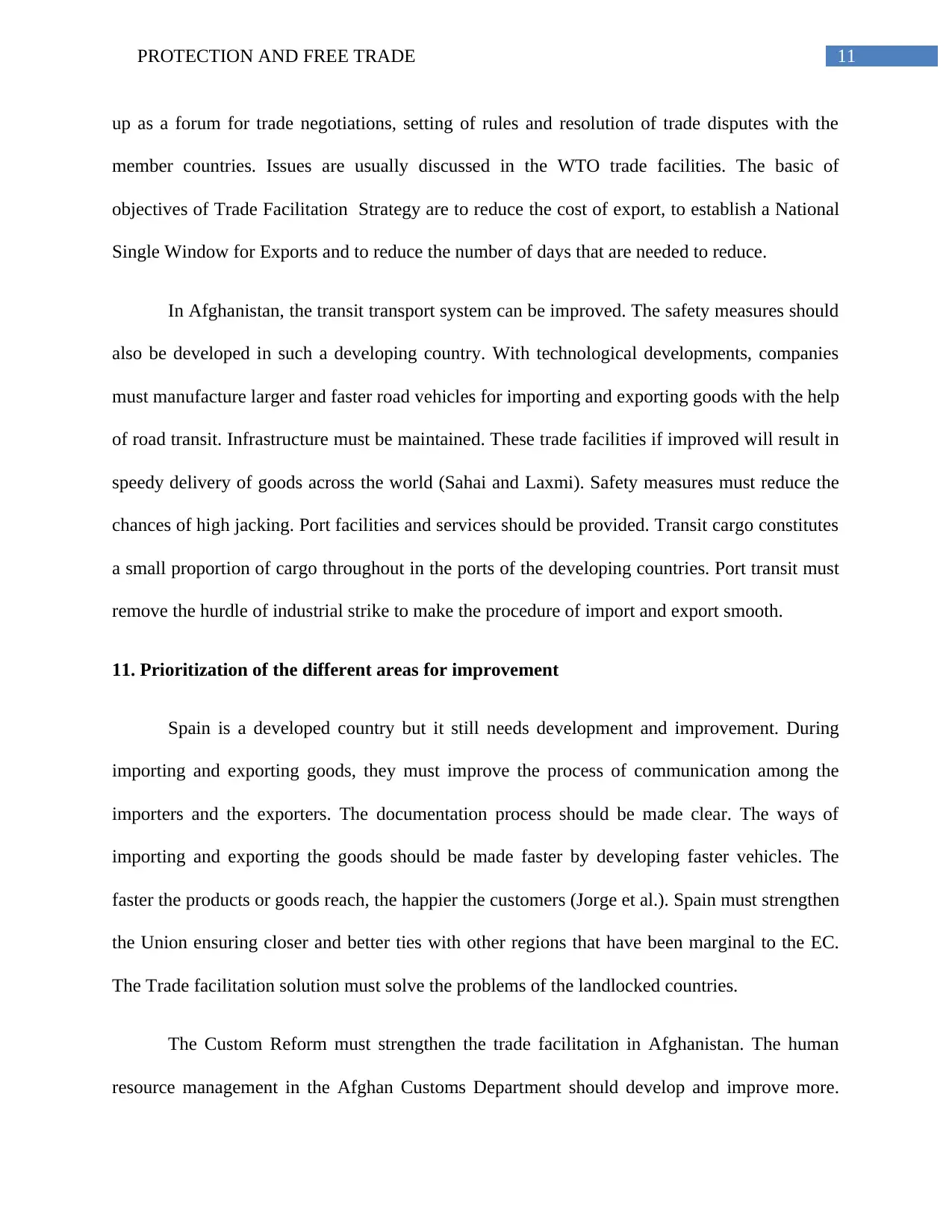
11PROTECTION AND FREE TRADE
up as a forum for trade negotiations, setting of rules and resolution of trade disputes with the
member countries. Issues are usually discussed in the WTO trade facilities. The basic of
objectives of Trade Facilitation Strategy are to reduce the cost of export, to establish a National
Single Window for Exports and to reduce the number of days that are needed to reduce.
In Afghanistan, the transit transport system can be improved. The safety measures should
also be developed in such a developing country. With technological developments, companies
must manufacture larger and faster road vehicles for importing and exporting goods with the help
of road transit. Infrastructure must be maintained. These trade facilities if improved will result in
speedy delivery of goods across the world (Sahai and Laxmi). Safety measures must reduce the
chances of high jacking. Port facilities and services should be provided. Transit cargo constitutes
a small proportion of cargo throughout in the ports of the developing countries. Port transit must
remove the hurdle of industrial strike to make the procedure of import and export smooth.
11. Prioritization of the different areas for improvement
Spain is a developed country but it still needs development and improvement. During
importing and exporting goods, they must improve the process of communication among the
importers and the exporters. The documentation process should be made clear. The ways of
importing and exporting the goods should be made faster by developing faster vehicles. The
faster the products or goods reach, the happier the customers (Jorge et al.). Spain must strengthen
the Union ensuring closer and better ties with other regions that have been marginal to the EC.
The Trade facilitation solution must solve the problems of the landlocked countries.
The Custom Reform must strengthen the trade facilitation in Afghanistan. The human
resource management in the Afghan Customs Department should develop and improve more.
up as a forum for trade negotiations, setting of rules and resolution of trade disputes with the
member countries. Issues are usually discussed in the WTO trade facilities. The basic of
objectives of Trade Facilitation Strategy are to reduce the cost of export, to establish a National
Single Window for Exports and to reduce the number of days that are needed to reduce.
In Afghanistan, the transit transport system can be improved. The safety measures should
also be developed in such a developing country. With technological developments, companies
must manufacture larger and faster road vehicles for importing and exporting goods with the help
of road transit. Infrastructure must be maintained. These trade facilities if improved will result in
speedy delivery of goods across the world (Sahai and Laxmi). Safety measures must reduce the
chances of high jacking. Port facilities and services should be provided. Transit cargo constitutes
a small proportion of cargo throughout in the ports of the developing countries. Port transit must
remove the hurdle of industrial strike to make the procedure of import and export smooth.
11. Prioritization of the different areas for improvement
Spain is a developed country but it still needs development and improvement. During
importing and exporting goods, they must improve the process of communication among the
importers and the exporters. The documentation process should be made clear. The ways of
importing and exporting the goods should be made faster by developing faster vehicles. The
faster the products or goods reach, the happier the customers (Jorge et al.). Spain must strengthen
the Union ensuring closer and better ties with other regions that have been marginal to the EC.
The Trade facilitation solution must solve the problems of the landlocked countries.
The Custom Reform must strengthen the trade facilitation in Afghanistan. The human
resource management in the Afghan Customs Department should develop and improve more.
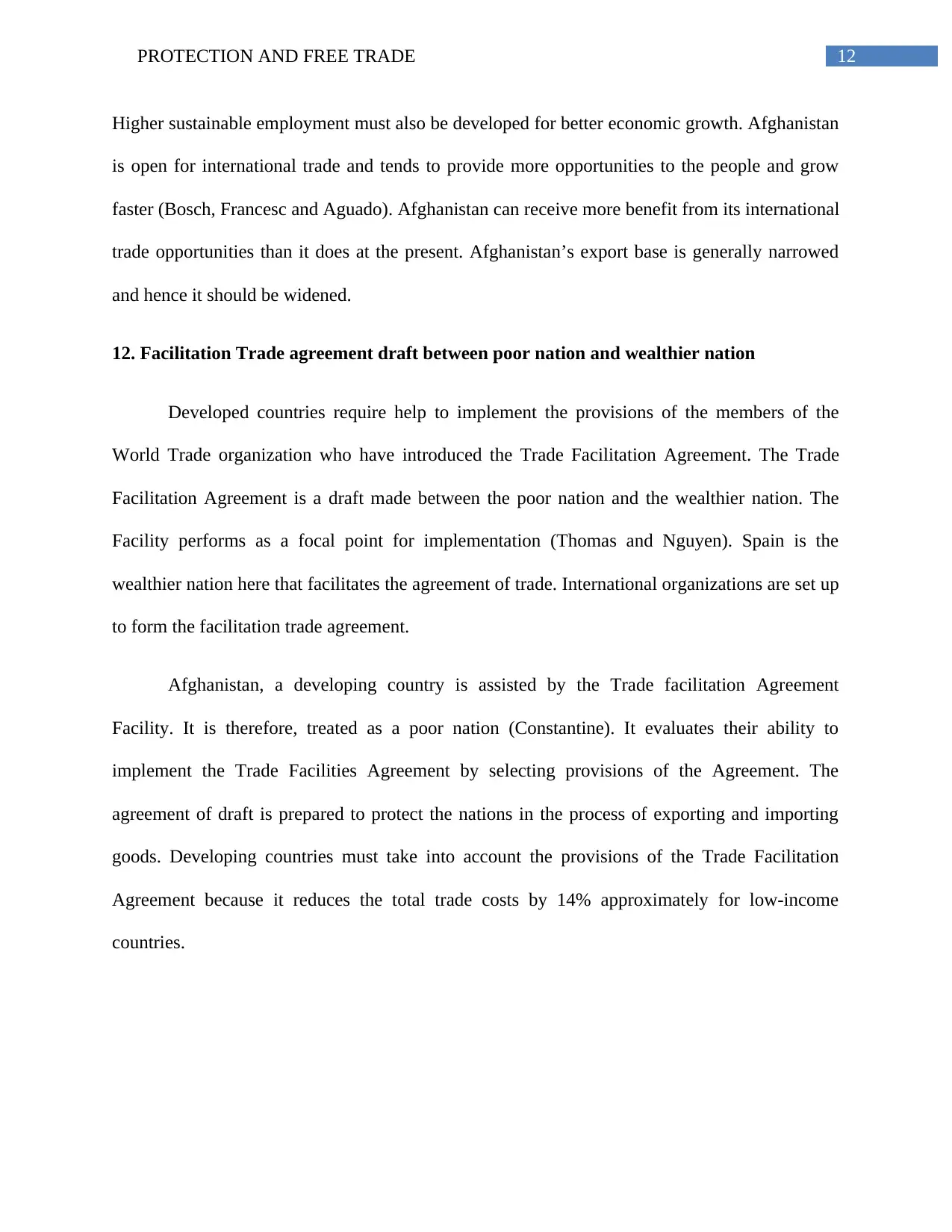
12PROTECTION AND FREE TRADE
Higher sustainable employment must also be developed for better economic growth. Afghanistan
is open for international trade and tends to provide more opportunities to the people and grow
faster (Bosch, Francesc and Aguado). Afghanistan can receive more benefit from its international
trade opportunities than it does at the present. Afghanistan’s export base is generally narrowed
and hence it should be widened.
12. Facilitation Trade agreement draft between poor nation and wealthier nation
Developed countries require help to implement the provisions of the members of the
World Trade organization who have introduced the Trade Facilitation Agreement. The Trade
Facilitation Agreement is a draft made between the poor nation and the wealthier nation. The
Facility performs as a focal point for implementation (Thomas and Nguyen). Spain is the
wealthier nation here that facilitates the agreement of trade. International organizations are set up
to form the facilitation trade agreement.
Afghanistan, a developing country is assisted by the Trade facilitation Agreement
Facility. It is therefore, treated as a poor nation (Constantine). It evaluates their ability to
implement the Trade Facilities Agreement by selecting provisions of the Agreement. The
agreement of draft is prepared to protect the nations in the process of exporting and importing
goods. Developing countries must take into account the provisions of the Trade Facilitation
Agreement because it reduces the total trade costs by 14% approximately for low-income
countries.
Higher sustainable employment must also be developed for better economic growth. Afghanistan
is open for international trade and tends to provide more opportunities to the people and grow
faster (Bosch, Francesc and Aguado). Afghanistan can receive more benefit from its international
trade opportunities than it does at the present. Afghanistan’s export base is generally narrowed
and hence it should be widened.
12. Facilitation Trade agreement draft between poor nation and wealthier nation
Developed countries require help to implement the provisions of the members of the
World Trade organization who have introduced the Trade Facilitation Agreement. The Trade
Facilitation Agreement is a draft made between the poor nation and the wealthier nation. The
Facility performs as a focal point for implementation (Thomas and Nguyen). Spain is the
wealthier nation here that facilitates the agreement of trade. International organizations are set up
to form the facilitation trade agreement.
Afghanistan, a developing country is assisted by the Trade facilitation Agreement
Facility. It is therefore, treated as a poor nation (Constantine). It evaluates their ability to
implement the Trade Facilities Agreement by selecting provisions of the Agreement. The
agreement of draft is prepared to protect the nations in the process of exporting and importing
goods. Developing countries must take into account the provisions of the Trade Facilitation
Agreement because it reduces the total trade costs by 14% approximately for low-income
countries.
Paraphrase This Document
Need a fresh take? Get an instant paraphrase of this document with our AI Paraphraser
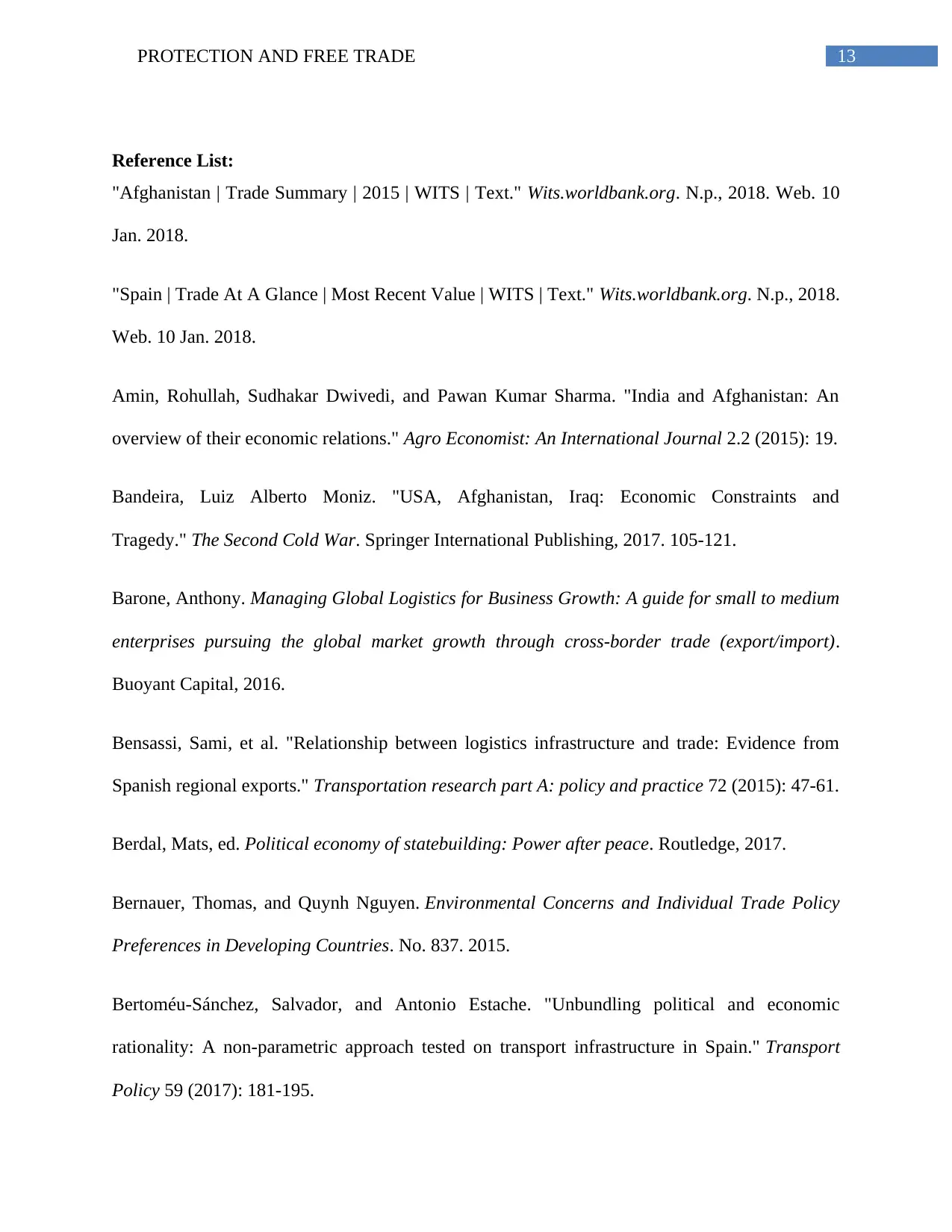
13PROTECTION AND FREE TRADE
Reference List:
"Afghanistan | Trade Summary | 2015 | WITS | Text." Wits.worldbank.org. N.p., 2018. Web. 10
Jan. 2018.
"Spain | Trade At A Glance | Most Recent Value | WITS | Text." Wits.worldbank.org. N.p., 2018.
Web. 10 Jan. 2018.
Amin, Rohullah, Sudhakar Dwivedi, and Pawan Kumar Sharma. "India and Afghanistan: An
overview of their economic relations." Agro Economist: An International Journal 2.2 (2015): 19.
Bandeira, Luiz Alberto Moniz. "USA, Afghanistan, Iraq: Economic Constraints and
Tragedy." The Second Cold War. Springer International Publishing, 2017. 105-121.
Barone, Anthony. Managing Global Logistics for Business Growth: A guide for small to medium
enterprises pursuing the global market growth through cross-border trade (export/import).
Buoyant Capital, 2016.
Bensassi, Sami, et al. "Relationship between logistics infrastructure and trade: Evidence from
Spanish regional exports." Transportation research part A: policy and practice 72 (2015): 47-61.
Berdal, Mats, ed. Political economy of statebuilding: Power after peace. Routledge, 2017.
Bernauer, Thomas, and Quynh Nguyen. Environmental Concerns and Individual Trade Policy
Preferences in Developing Countries. No. 837. 2015.
Bertoméu-Sánchez, Salvador, and Antonio Estache. "Unbundling political and economic
rationality: A non-parametric approach tested on transport infrastructure in Spain." Transport
Policy 59 (2017): 181-195.
Reference List:
"Afghanistan | Trade Summary | 2015 | WITS | Text." Wits.worldbank.org. N.p., 2018. Web. 10
Jan. 2018.
"Spain | Trade At A Glance | Most Recent Value | WITS | Text." Wits.worldbank.org. N.p., 2018.
Web. 10 Jan. 2018.
Amin, Rohullah, Sudhakar Dwivedi, and Pawan Kumar Sharma. "India and Afghanistan: An
overview of their economic relations." Agro Economist: An International Journal 2.2 (2015): 19.
Bandeira, Luiz Alberto Moniz. "USA, Afghanistan, Iraq: Economic Constraints and
Tragedy." The Second Cold War. Springer International Publishing, 2017. 105-121.
Barone, Anthony. Managing Global Logistics for Business Growth: A guide for small to medium
enterprises pursuing the global market growth through cross-border trade (export/import).
Buoyant Capital, 2016.
Bensassi, Sami, et al. "Relationship between logistics infrastructure and trade: Evidence from
Spanish regional exports." Transportation research part A: policy and practice 72 (2015): 47-61.
Berdal, Mats, ed. Political economy of statebuilding: Power after peace. Routledge, 2017.
Bernauer, Thomas, and Quynh Nguyen. Environmental Concerns and Individual Trade Policy
Preferences in Developing Countries. No. 837. 2015.
Bertoméu-Sánchez, Salvador, and Antonio Estache. "Unbundling political and economic
rationality: A non-parametric approach tested on transport infrastructure in Spain." Transport
Policy 59 (2017): 181-195.
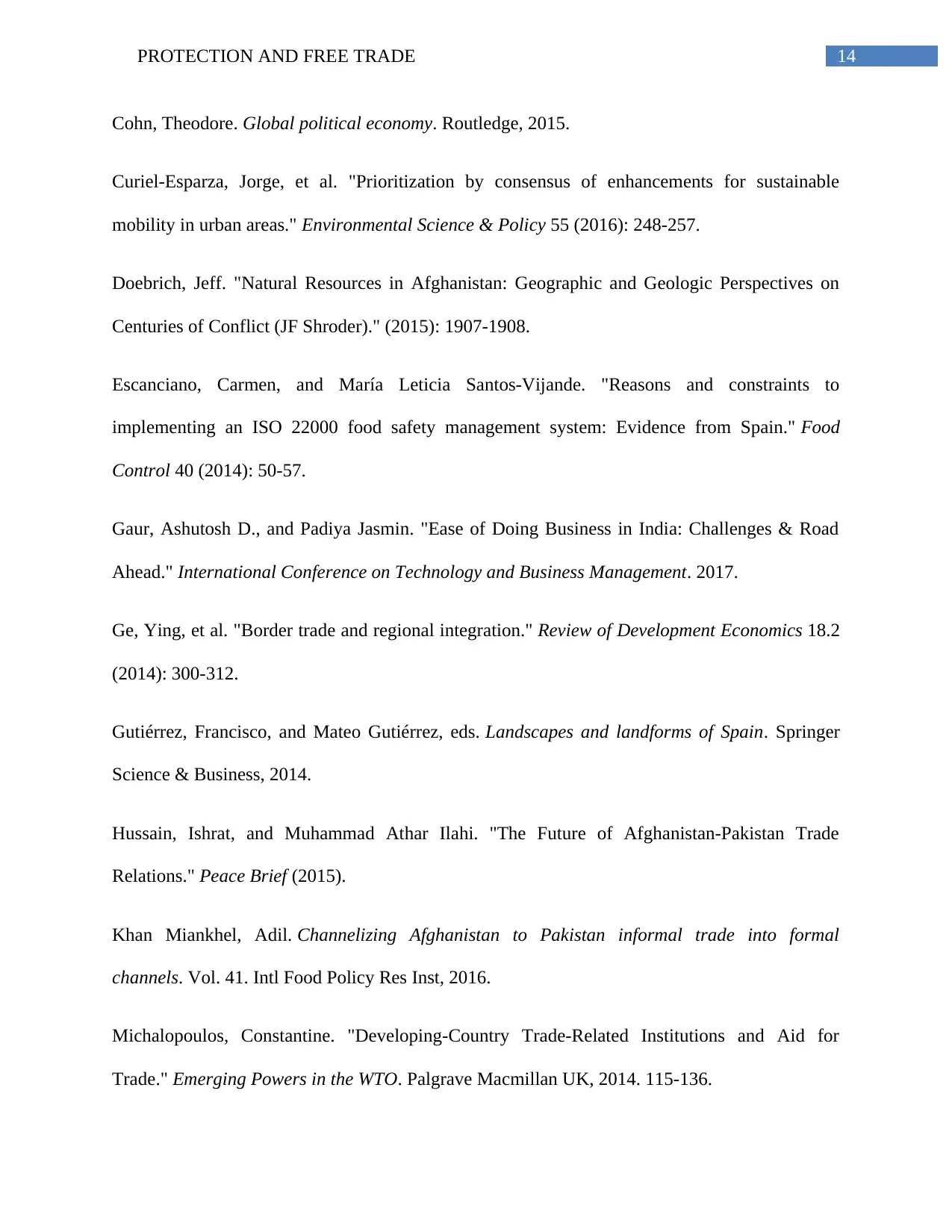
14PROTECTION AND FREE TRADE
Cohn, Theodore. Global political economy. Routledge, 2015.
Curiel-Esparza, Jorge, et al. "Prioritization by consensus of enhancements for sustainable
mobility in urban areas." Environmental Science & Policy 55 (2016): 248-257.
Doebrich, Jeff. "Natural Resources in Afghanistan: Geographic and Geologic Perspectives on
Centuries of Conflict (JF Shroder)." (2015): 1907-1908.
Escanciano, Carmen, and María Leticia Santos-Vijande. "Reasons and constraints to
implementing an ISO 22000 food safety management system: Evidence from Spain." Food
Control 40 (2014): 50-57.
Gaur, Ashutosh D., and Padiya Jasmin. "Ease of Doing Business in India: Challenges & Road
Ahead." International Conference on Technology and Business Management. 2017.
Ge, Ying, et al. "Border trade and regional integration." Review of Development Economics 18.2
(2014): 300-312.
Gutiérrez, Francisco, and Mateo Gutiérrez, eds. Landscapes and landforms of Spain. Springer
Science & Business, 2014.
Hussain, Ishrat, and Muhammad Athar Ilahi. "The Future of Afghanistan-Pakistan Trade
Relations." Peace Brief (2015).
Khan Miankhel, Adil. Channelizing Afghanistan to Pakistan informal trade into formal
channels. Vol. 41. Intl Food Policy Res Inst, 2016.
Michalopoulos, Constantine. "Developing-Country Trade-Related Institutions and Aid for
Trade." Emerging Powers in the WTO. Palgrave Macmillan UK, 2014. 115-136.
Cohn, Theodore. Global political economy. Routledge, 2015.
Curiel-Esparza, Jorge, et al. "Prioritization by consensus of enhancements for sustainable
mobility in urban areas." Environmental Science & Policy 55 (2016): 248-257.
Doebrich, Jeff. "Natural Resources in Afghanistan: Geographic and Geologic Perspectives on
Centuries of Conflict (JF Shroder)." (2015): 1907-1908.
Escanciano, Carmen, and María Leticia Santos-Vijande. "Reasons and constraints to
implementing an ISO 22000 food safety management system: Evidence from Spain." Food
Control 40 (2014): 50-57.
Gaur, Ashutosh D., and Padiya Jasmin. "Ease of Doing Business in India: Challenges & Road
Ahead." International Conference on Technology and Business Management. 2017.
Ge, Ying, et al. "Border trade and regional integration." Review of Development Economics 18.2
(2014): 300-312.
Gutiérrez, Francisco, and Mateo Gutiérrez, eds. Landscapes and landforms of Spain. Springer
Science & Business, 2014.
Hussain, Ishrat, and Muhammad Athar Ilahi. "The Future of Afghanistan-Pakistan Trade
Relations." Peace Brief (2015).
Khan Miankhel, Adil. Channelizing Afghanistan to Pakistan informal trade into formal
channels. Vol. 41. Intl Food Policy Res Inst, 2016.
Michalopoulos, Constantine. "Developing-Country Trade-Related Institutions and Aid for
Trade." Emerging Powers in the WTO. Palgrave Macmillan UK, 2014. 115-136.
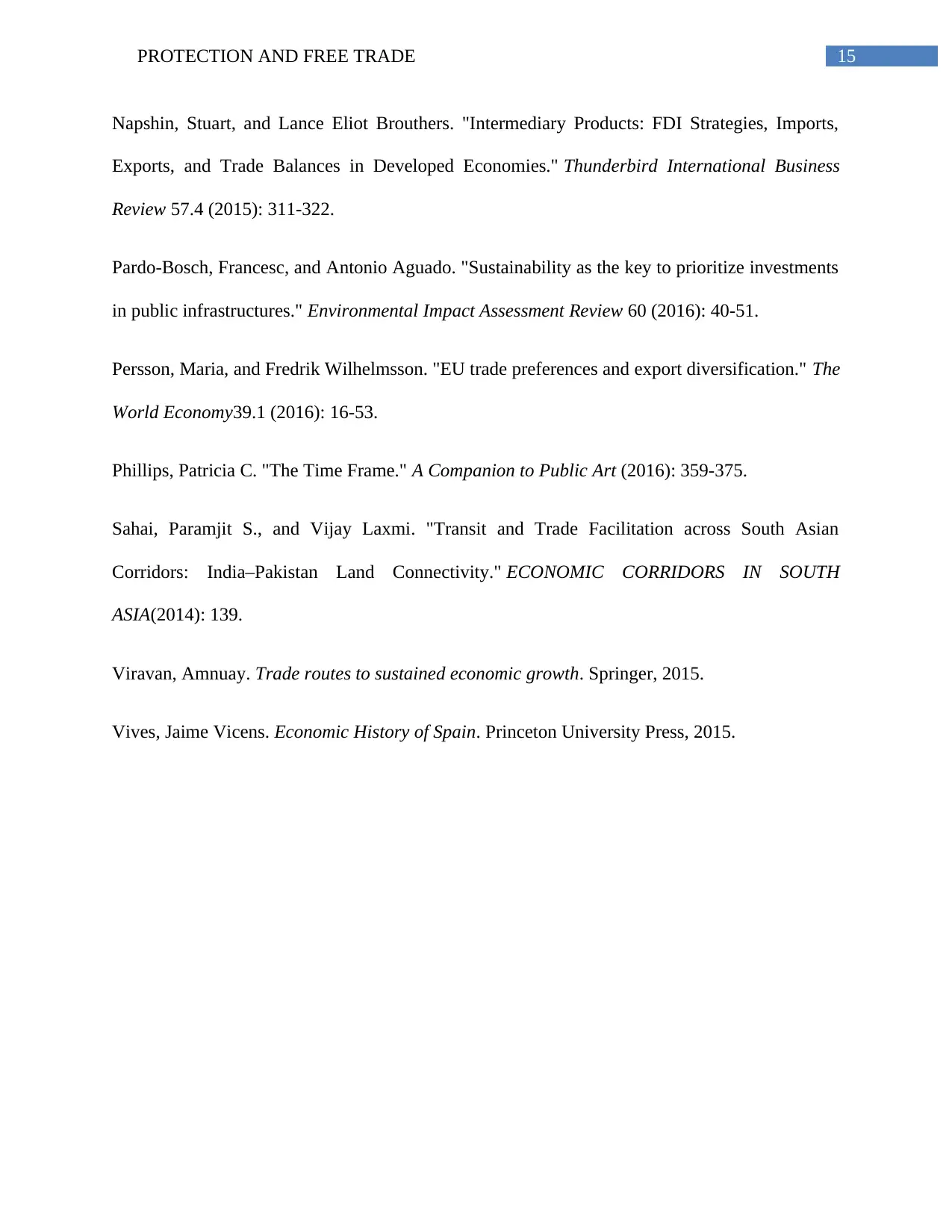
15PROTECTION AND FREE TRADE
Napshin, Stuart, and Lance Eliot Brouthers. "Intermediary Products: FDI Strategies, Imports,
Exports, and Trade Balances in Developed Economies." Thunderbird International Business
Review 57.4 (2015): 311-322.
Pardo-Bosch, Francesc, and Antonio Aguado. "Sustainability as the key to prioritize investments
in public infrastructures." Environmental Impact Assessment Review 60 (2016): 40-51.
Persson, Maria, and Fredrik Wilhelmsson. "EU trade preferences and export diversification." The
World Economy39.1 (2016): 16-53.
Phillips, Patricia C. "The Time Frame." A Companion to Public Art (2016): 359-375.
Sahai, Paramjit S., and Vijay Laxmi. "Transit and Trade Facilitation across South Asian
Corridors: India–Pakistan Land Connectivity." ECONOMIC CORRIDORS IN SOUTH
ASIA(2014): 139.
Viravan, Amnuay. Trade routes to sustained economic growth. Springer, 2015.
Vives, Jaime Vicens. Economic History of Spain. Princeton University Press, 2015.
Napshin, Stuart, and Lance Eliot Brouthers. "Intermediary Products: FDI Strategies, Imports,
Exports, and Trade Balances in Developed Economies." Thunderbird International Business
Review 57.4 (2015): 311-322.
Pardo-Bosch, Francesc, and Antonio Aguado. "Sustainability as the key to prioritize investments
in public infrastructures." Environmental Impact Assessment Review 60 (2016): 40-51.
Persson, Maria, and Fredrik Wilhelmsson. "EU trade preferences and export diversification." The
World Economy39.1 (2016): 16-53.
Phillips, Patricia C. "The Time Frame." A Companion to Public Art (2016): 359-375.
Sahai, Paramjit S., and Vijay Laxmi. "Transit and Trade Facilitation across South Asian
Corridors: India–Pakistan Land Connectivity." ECONOMIC CORRIDORS IN SOUTH
ASIA(2014): 139.
Viravan, Amnuay. Trade routes to sustained economic growth. Springer, 2015.
Vives, Jaime Vicens. Economic History of Spain. Princeton University Press, 2015.
1 out of 16
Related Documents
Your All-in-One AI-Powered Toolkit for Academic Success.
+13062052269
info@desklib.com
Available 24*7 on WhatsApp / Email
![[object Object]](/_next/static/media/star-bottom.7253800d.svg)
Unlock your academic potential
© 2024 | Zucol Services PVT LTD | All rights reserved.





